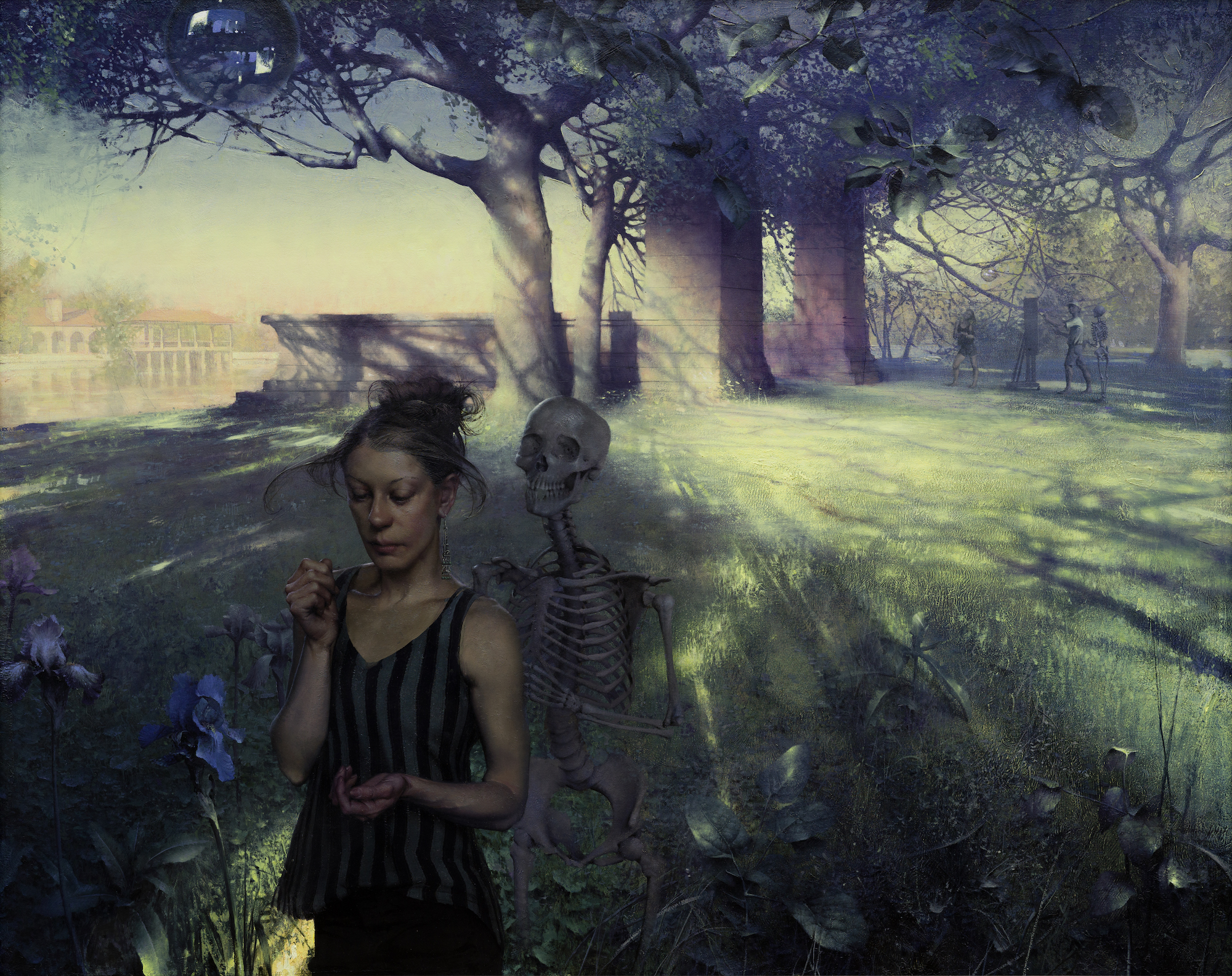Death and the Maiden
Death and The Maiden Audio
Death in the Maiden. It’s a title of a quartet by Fran Schubert’s in the early 19th century or late 18th. It’s a title that came to me after I’d painted this. I worked on the figure and really all I had for a long time during the course of this painting was. The model, her name is Destiny, and with the flowers, and the kind of dappled sunlight in the park, and okay, it was getting too sweet for me, and I thought, yeah, I need to add a little counterbalance to life, so I added the skeleton kind of breathing down her neck.
I can always second guess myself, was that a good idea or a bad one, but it’s there now. I made it really discreet in the shadows, which I tend to do with really subjects that would call a lot of attention to themselves. I like kind of put ’em in shadow. In fact, this painting is an example of where I put the psychological center in secondary to the compositional center.
And the compositional center would be where the bright light in the tree in the sky. That’s where what really makes the composition here so I have the psychological elements in shadow. This is my own description. I’ve never really heard about art spoken about this way, but it makes a lot of sense.
After I painted the, you know, death and the maiden breathing down her neck, I felt kind of bad about it. A little guilty about it, I’m superstitious. So to equalize the menace, I did another narrative over in the upper, center right of the painting. That’s me painting this painting, with death breathing down my neck, and the model is posing unthreatened, I guess you could say.
So I earlier said that I think death is nothing to be afraid of, but of course we know the fear of death is the most natural thing in the world. I have it, it’s this mixed, mix that we have in our existence. We have a certain brain circuitry that allows us to deny death, at the same time being aware of it.
It’s, it’s strange. It’s a survival mechanism. In this painting, there’s the glass globe, and it’s a symbol that I became enamored with through the works of, uh, Johannes Vermeer. In this one, you can see that there’s square reflections in there. Well, those are reflections from my studio. So the glass globe was painted in the studio.
It’s a little wink. to the viewer that you know, if you think about it, that it would not appear that way if the globe was hanging outside. But I like those square highlights. I like the way they look better, but then it would if it were outside because there’s just encompasses too much, more than I can really paint.
But the other is that it’s an art historic reference to Jan van Eyck in his painting of the Altarpiece of the Lamb. There’s an italic piece that reflects the interior of the room when the scene is an outdoor setting. I noticed that. You have to look really closely to see that, but I like that. So another thing about the story being told, again, on the right, has to do with the works of Michelangelo on the Sistine Ceiling and other Renaissance paintings where the narrative would be indicated twice, say, before and after the event.
Say, like, Adam and Eve before they eat the apple, and then Adam and Eve when they’re expelled from the garden. And I just think it’s a beautiful device from the Renaissance that I still use. I mean, I still think it’s enjoyable when I indulge in narrative, which that’s another story. You know, the pandemic really took hold of our consciousness in the United States and worldwide, like hardly any event that I’m aware of in my entire life.
It’s just been nothing like, especially in the early days of the pandemic, no one knew how serious it was going to be, if it was going to end up like the 1918 that wiped out like one third of the earth’s population. Thankfully it didn’t turn out that bad, but we didn’t know. But actually I painted this and finished it long before the pandemic.
It didn’t give it any thought, but to me, uh, it had a little more relevance after I had painted it.
